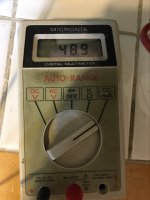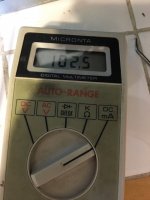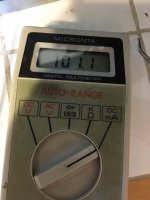I think the AC/DC switch on your meter will only apply to voltage readings. Most small meters like that do not have AC current ranges.Okay, I had to have the slide switch in the AC position.
By measuring current in the motor lead directly we are measuring a DC quantity. The readings you are getting (last post) don't look viable tbh. With the belt off the motor should draw a few tens of milliamps and perhaps a 150ma or a little more when driving the mechanism.
(If you have any resistors available in the 100 to 1k range then you can check your meter is reading correctly by measuring the current in the resistor when connected across a known voltage. For example a 1k connected across a 9v battery (that actually reads say 7.8 volts with the resistor across it) would give a current of 7.8 milliamps)
Last edited by a moderator:
Hi Mooly,Those look in the right sort of ball park. Nothing should be getting hot or burning with those levels.
Is the 48ma vs the 102ma without and with the belt fitted?
Yes, the pictures are captioned as to which ones are with the belt on and off.
So you think the motor is fine and maybe I should look elsewhere such as an out of range capacitor feeding the motor like C312?
The numbers are drifting quite a bit.
It is not drawing excess current but that does not mean its OK in other respects. With the belt OFF then the current draw should be fairly constant although a digital meter can 'bounce' around a bit making things look worse than they are. Something like 48, 46, 53, 47, 48, 51 and so on would be acceptable I think.
This is still a bit of a mystery at this point:
The cap is easy to prove, you just tag another across it. Anything in the 470uF to 2200uF range would prove that but I don't really think it will be the issue. You could also try feeding the motor from a fresh 9 volt alkaline battery and just see if it seems better or not. 9v would probably just about be OK to power it in play mode.
If you are sure the mechanical side of things are good then that only leaves the motor. They used to be readily available but I suspect that isn't the case today. In the first instance you need to check whether it is clockwise (CW) or counter clockwise (CCW) rotation. Spindle speed was commonly 2400 rpm from memory for all these type of motors.
This is still a bit of a mystery at this point:
Also when this problem first appeared over the weekend I noticed a heavy burning smell from the unit like something was overheated. Took the cover off and could trace the source of the smell to the transformer.
The cap is easy to prove, you just tag another across it. Anything in the 470uF to 2200uF range would prove that but I don't really think it will be the issue. You could also try feeding the motor from a fresh 9 volt alkaline battery and just see if it seems better or not. 9v would probably just about be OK to power it in play mode.
If you are sure the mechanical side of things are good then that only leaves the motor. They used to be readily available but I suspect that isn't the case today. In the first instance you need to check whether it is clockwise (CW) or counter clockwise (CCW) rotation. Spindle speed was commonly 2400 rpm from memory for all these type of motors.
A bit more info on the motors... and opening up these motors is definitely on the cards. They usually come apart, the back cover either prises off or occasionally a grub screw is fitted.
There were a few types around commonly although they share the same fixings and usually same spindle diameter (something to bear in mind). Some of the better motors were of a 'FG' or frequency generator type which simply meant the speed was controlled and referenced to a built in oscillator. These had the best speed stability. Next were the simple inbuilt transistor regulator type that sense back EMF from the motor and use that to maintain a reasonably constant speed. In fairness they are pretty decent but have the lowest torque of all the different types.
Before those (your won't be this type) were mechanically governed motors with tiny bob weights on the armature that opened an electrical leaf switch on each armature winding when the correct speed was reached. Non adjustable speed wise from a user point of view but the torque and power from these was highest of any type. Often used in car players.
There were a few types around commonly although they share the same fixings and usually same spindle diameter (something to bear in mind). Some of the better motors were of a 'FG' or frequency generator type which simply meant the speed was controlled and referenced to a built in oscillator. These had the best speed stability. Next were the simple inbuilt transistor regulator type that sense back EMF from the motor and use that to maintain a reasonably constant speed. In fairness they are pretty decent but have the lowest torque of all the different types.
Before those (your won't be this type) were mechanically governed motors with tiny bob weights on the armature that opened an electrical leaf switch on each armature winding when the correct speed was reached. Non adjustable speed wise from a user point of view but the torque and power from these was highest of any type. Often used in car players.
Hi Mooly,
I'm not sure if it's okay to link to eBay here (if not please delete the link) but I just purchased an exact OEM NOS motor for $30 just for insurance and the fact mine is an old and well used original.
https://www.ebay.com/itm/373937899282?hash=item57106f8712:g:SH0AAOSwrlliDpDw
I will also look when I'm at home for a suitable capacitor and swap it out since it very easy to access.
I'm not sure if it's okay to link to eBay here (if not please delete the link) but I just purchased an exact OEM NOS motor for $30 just for insurance and the fact mine is an old and well used original.
https://www.ebay.com/itm/373937899282?hash=item57106f8712:g:SH0AAOSwrlliDpDw
I will also look when I'm at home for a suitable capacitor and swap it out since it very easy to access.
That's fine 👍 and you are lucky to get that.
So that is one of the better ones and has the regulating transistor bolted to the side. I think it might also (it's 50:50) be an FG type. Some were in that style. They do come apart really easily as well.
I'll look in again tomorrow 🙂
So that is one of the better ones and has the regulating transistor bolted to the side. I think it might also (it's 50:50) be an FG type. Some were in that style. They do come apart really easily as well.
I'll look in again tomorrow 🙂
I couldn't believe it when I searched eBay for the motor part number and that was one of the first sellers to pop up in the list. (and they look to be 100 percent genuine NOS since he has 70 of them with the original manufacturing label, packaging/shipping and Styrofoam cradles)That's fine 👍 and you are lucky to get that.
So that is one of the better ones and has the regulating transistor bolted to the side. I think it might also (it's 50:50) be an FG type. Some were in that style. They do come apart really easily as well.
I'll look in again tomorrow 🙂
So naturally for $30 I grabbed one.
Oh, and the burning smell might have been an over-reaction on my part as it's more of an electrical type of smell from that era of electronics. My brother says his old late seventies Nakamichi 600 has the same kind of smell.
$10 is too much here, but then Mabuchi or Chinese.
Not NOS OEM.
Good you found one, they are scarce.
Some of the motors have a tiny preset on the back, hidden under a cover, for very occasional speed setting, you need a watch maker's screwdriver, or similar to do it..
Those may not have a FG circuit.
Just check the new motor for performance, electrically, and mechanically, before fitting.
Not NOS OEM.
Good you found one, they are scarce.
Some of the motors have a tiny preset on the back, hidden under a cover, for very occasional speed setting, you need a watch maker's screwdriver, or similar to do it..
Those may not have a FG circuit.
Just check the new motor for performance, electrically, and mechanically, before fitting.
Last edited:
Hi Naresh,$10 is too much here, but then Mabuchi or Chinese.
Not NOS OEM.
Good you found one, they are scarce.
Some of the motors have a tiny preset on the back, hidden under a cover, for very occasional speed setting, you need a watch maker's screwdriver, or similar to do it..
Those may not have a FG circuit.
Just check the new motor for performance, electrically, and mechanically, before fitting.
Yes, I tried the speed adjustment as one of the first things when I started to notice the pitch of the voices in the music was not sounding right.
I will also test the motor prior to removing the old one and installing the replacement unit.
- Home
- Source & Line
- Analogue Source
- My Yamaha TC-520 Cassette Deck appears to have a power transformer problem


